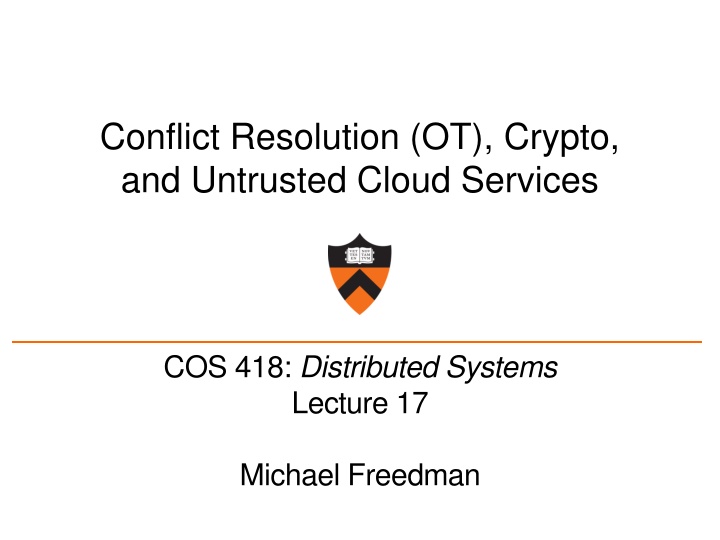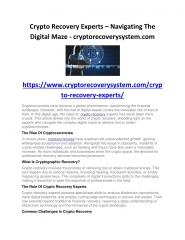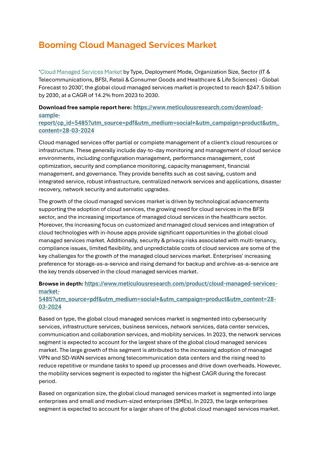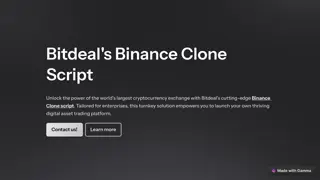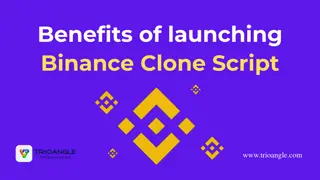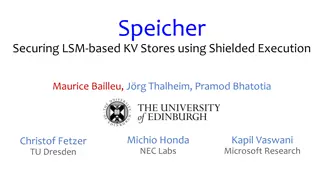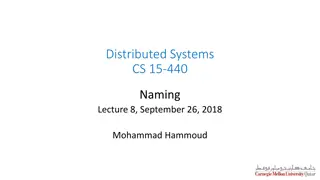Conflict Resolution in Distributed Systems: OT, Crypto, and Untrusted Cloud Services
Explore the complexities of conflict resolution in distributed systems, focusing on Operational Transformation (OT), cryptographic techniques, and handling data in untrusted cloud environments. Learn about concurrent writes, encoding operations as incremental updates, and consider shared word processing challenges in a distributed setting.
Uploaded on Sep 18, 2024 | 2 Views
Download Presentation

Please find below an Image/Link to download the presentation.
The content on the website is provided AS IS for your information and personal use only. It may not be sold, licensed, or shared on other websites without obtaining consent from the author.If you encounter any issues during the download, it is possible that the publisher has removed the file from their server.
You are allowed to download the files provided on this website for personal or commercial use, subject to the condition that they are used lawfully. All files are the property of their respective owners.
The content on the website is provided AS IS for your information and personal use only. It may not be sold, licensed, or shared on other websites without obtaining consent from the author.
E N D
Presentation Transcript
Conflict Resolution (OT), Crypto, and Untrusted Cloud Services COS 418: Distributed Systems Lecture 17 Michael Freedman
Warning: lecture jumps This around But there is some logic + crypto background for blockchain 2
Todays Topics Conflict resolution Operational Transformation (OT) Crypto Introduction Crypto (encryption, digital signatures), hash functions Untrusted Cloud Storage (SPORC) OT + crypto + fork* consistency Next lecture: Bitcoin and blockchains and consensus, oh my! 3
Concurrent writes can conflict Encountered in many different settings: Peer-to-peer (Bayou) Multi-master: single cluster (Dynamo), wide-area (COPS) Potential solutions Last writer wins Thomas Write Rule for DBs with timestamp-based concurrency control: Ignore outdated writes Application-specific merge/update: Bayou, Dynamo 5
General approach: Encode ops as incremental update Consider banking (double-entry bookkeeping): Initial: Alice = $50, Bob = $20 Alice pays Bob $10 Option 1: set Alice to $40, set Bob to $30 Option 2: decrement Alice -$10, incremental Bob +$10 #2 better, but can t always ensure Alice >= $0 Works because common mathematical ops are Commutative: A B == B A Invertible: A A-1 == 1 6
Consider shared word processing How do I insert a new word? Send entire doc to server? Not efficient Send update operation! 7
Consider shared word processing How do I insert a new word? Send entire doc to server? Not efficient Send update operation! insert (string, position) = insert( 1500s , 166) Warning: Insert (rather than replace) shifted position of all following text 8
Operations must be commutative $40 A Withdraw $10 Deposit $15 Insert Delete (1, 0) ( 1500s , 166) $30 $55 B C Deposit $15 Withdraw $10 Delete (1, 0) $45 D [ delete 1 char as pos 0 ] 9
Operations must be commutative $40 A Withdraw $10 Deposit $15 Insert Delete (1, 0) ( 1500s , 166) $30 $55 B C Deposit $15 Withdraw $10 Delete (1, 0) Insert ( 1500s , 166) $45 D [ delete 1 char as pos 0 ] PROBLEM! 10
Operations must be commutative $40 A Withdraw $10 Deposit $15 Insert Delete (1, 0) ( 1500s , 166) $30 $55 B C Deposit $15 Withdraw $10 Delete (1, 0) Insert ( 1500s , 165) $45 D [ delete 1 char as pos 0 ] 11
Operations must be commutative $40 A Withdraw $10 Deposit $15 Insert Delete (1, 0) ( 1500s , 166) $30 $55 B C Deposit $15 Withdraw $10 $45 E D F G H 12
Operational Transformation (OT) State of system is S, ops a and b performed by concurrently on state S Different servers can apply concurrent ops in different sequential order Server 1: Receives a, applies a to state S: S a Receives b (which is dependent on S, not S a ) Transforms b across all ops applied since S (namely a): b = OT( b, { a }) Applies b to state: S a b Server 2 Receives b, applies b to state: S b Receives a, performs transformation a = OT( a, { b }), Applies a to state: S b a Servers 1 and 2 have identical final states: S a b == S b a 13
Operational Transformation (OT) (Used in Google Docs, EtherPad, etc.) Server Alice Bob ABCDE ABCDE State: State: ins ABC ins DE ins ABC ins DE Ops: Ops: 14
Operational Transformation (OT) (Used in Google Docs, EtherPad, etc.) Server del 2 del 4 Alice Bob ACDE ABCE State: State: ins ABC ins DE ins ABC ins DE Ops: Ops: del 2 del 4 15
Operational Transformation (OT) (Used in Google Docs, EtherPad, etc.) Server Alice Bob ACD ACE State: State: ins ABC ins DE ins ABC ins DE Ops: Ops: del 2 del 4 del 4 del 2 del 2 16
Operational Transformation (OT) (Used in Google Docs, EtherPad, etc.) Server Alice Bob ACE ACE State: State: ins ABC ins DE ins ABC ins DE Ops: Ops: del 2 del 4 del 4 del 3 del 2 del 2 T T del 4 del 2 17
What is Cryptography? From Greek, meaning secret writing Confidentiality: encrypt data to hide content Include signature or message authentication code Integrity: Message has not been modified Authentication: Identify source of message encryption decryption ciphertext plaintext plaintext Modern encryption: Algorithm public, key secret and provides security Symmetric (shared secret) or asymmetric (public-private key) 20
Symmetric (Secret Key) Crypto Sender and recipient share common key Main challenge: How to distribute the key? Provides dual use: Confidentiality (encryption) Message authentication + integrity (MAC) 1000x more computationally efficient than asymmetric 21
Public-Key Cryptography Each party has (public key, private key) Alice s public key PK Known by anybody Bob uses PK to encrypt messages to Alice Bob uses PK to verify signatures from Alice Alice s private/secret key: sk Known only by Alice Alice uses sk to decrypt ciphertexts sent to her Alice uses sk to generate new signatures on messages 23
Public-Key Cryptography (PK, sk) = generateKey(keysize) Encryption API ciphertext = encrypt (message, PK) message = decrypt (ciphertext, sk) Digital signatures API Signature = sign (message, sk) isValid = verify (signature, message, PK) 24
(Simple) RSA Algorithm Generating a key: Generate composite n = p * q, where p and q are secret primes Pick public exponent e Solve for secret exponent d in d e 1 (mod (p -1) (q 1)) Public key = (e, n), private key = d Encrypting message m: c = me mod n Decrypting ciphertext c: m = cd mod n Security due to cost of factoring large numbers Finding (p,q) given n takes O(e log n log log n) operations n chosen to be 2048 or 4096 bits long 25
Cryptographic hash function ( and using them in systems ) 26
Cryptography Hash Functions I Take message m of arbitrary length and produces fixed-size (short) number H(m) One-way function Efficient: Easy to compute H(m) Hiding property: Hard to find an m, given H(m) Assumes m has sufficient entropy, not just { heads , tails } Random: Often assumes for output to look random 27
Cryptography Hash Functions II Collisions exist: | possible inputs | >> | possible outputs | but hard to find Collision resistance: Strong resistance: Find any m != m such that H(m) == H(m ) Weak resistance: Given m, find m such that H(m) == H(m ) For 160-bit hash (SHA-1) Finding any collision is birthday paradox: 2^{160/2} = 2^80 Finding specific collision requires 2^160 28
Hash Pointers h = H( ) (data) 30
Self-certifying names Fname = H( ) (data) P2P file sharing software (e.g., Limewire) File named by Fname = H (data) Participants verify that H (downloaded) == Fname 31
Self-certifying names Cname = H( ) H( ) H( ) H( ) H( ) chunk chunk chunk chunk chunk BitTorrent Large file split into smaller chunks (~256KB each) Torrent file specifies the name/hash of each chunk Participants verify that H (downloaded) == Cname Security relies on getting torrent file from trustworthy source 32
Hash chains H( ) prev: H( ) prev: H( ) prev: H( ) data data data Creates a tamper-evident log of data 33
Hash chains H( ) prev: H( ) prev: H( ) prev: H( ) data data data If data changes, all subsequent hash pointers change Otherwise, found a hash collision! 34
Untrusted Cloud Storage Operational Transformation + Hash Chains & Digital Signatures + Fork* Linearizability 36
SPORC: Group Collaboration using Untrusted Cloud Resources Ariel J. Feldman, William P. Zeller, Michael J. Freedman, Edward W. Felten OSDI 2010 37
SPORC goals Practical cloud apps Flexible framework Real-time collaboration Work offline Untrusted servers Can t read user data Can t tamper with user data without risking detection Clients can recover from tampering 38
Making servers untrusted Server App logic State Server Client 2 Client 1 Client App logic App logic 39
Making servers untrusted SPORC Server s limited role: Server App logic Encrypted state Storage Ordering msgs Client 2 Client 1 Copy of state App Copy of state App Client App logic logic App logic logic 40
How do you keep clients local copies consistent? Problem #1 (esp. with offline access) Server A Encrypted state Insert Delete (1, 0) ( 1500s , 166) B C Insert Delete (1, 0) ( 1500s , 165) D Client 2 Client 1 Copy of state App logic Copy of state App logic Client 41
How do you deal with a malicious server? Problem #2: Server Encrypted state Client 2 Client 1 Copy of state App logic Copy of state App logic Client 42
Dealing with a malicious server Digital signatures aren t enough Server Server can equivocate A B C C A fork* consistency [LM07] Honest server: linearizability Client Client Malicious server: Alice and Bob detect equivocation after exchanging 2 messages Embed hash chain in every msg Server can still fork the clients, but can t unfork 43
System design Client app Local state SPORC lib 44
System design Client app Local state Committed Pending fork* causally consistent consistent SPORC lib 45
System design Server Client app Local state Encrypted state Committed Pending Encrypt & sign SPORC lib 46
System design Server Client app Local state Encrypted state Committed Pending Compare history hash chains Client Verify & decrypt SPORC lib 47
System design Server Client app Local state Encrypted state Committed Pending If opk depends on opi, it includes H(opi || H(opi-1 || H(opi-2 )) Possible as ops sequentially ordered by server Compare history hash chains Client Verify & decrypt SPORC lib 48
System design Server Client app Local state Encrypted state Committed Pending T Client Decrypt & verify SPORC lib 49
System design Server Client app Local state Encrypted state Committed Pending T Client SPORC lib 50
Recovering from a fork Alice s history: Fork! Bob s history: Can use OT to resolve malicious forks too 51
